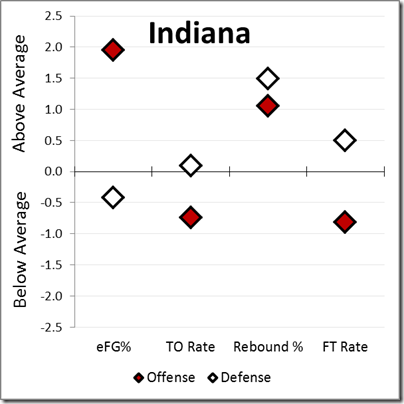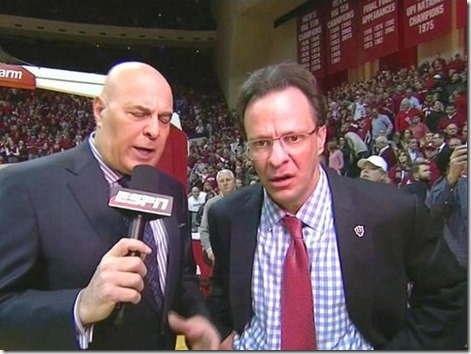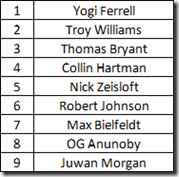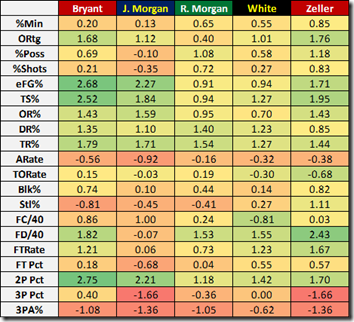2016-17 B1G Basketball Preview: Indiana

[Ed-Seth: Yes, basketball season is approaching. We'll jump early though]
Jim Harbaugh’s brother-in-law [SBNation]
PREVIOUSLY: Illinois.
After Indiana dropped two of three games (all against mediocre competition) in the Maui Invitational and were blown out in the ACC – Big Ten challenge by Duke, there was understandable unease among the Hoosier faithful; things took an even worse turn when their second-leading scorer, James Blackmon, Jr., was lost to a season-ending injury right before conference play. Because Tom Crean’s still at the helm of that particular ship, people started complaining about him again.
[More on the Hoosiers after the JUMP]
Indiana undeniably had talent – led by star senior floor general Yogi Ferrell – but it still came as somewhat of a surprise when they ran out to a great start in Big Ten play. They did have a few losses in the middle – lost in overtime at Wisconsin, dropped a close game at Penn State (the requisite derpy road loss for every Big Ten champion), were routed in their only matchup against Michigan State, also on the road – but those three were the only three and the Hoosiers finished 15-3 in conference play after some big wins down the stretch, two games ahead of second-place Michigan State.
Everything came together after a shaky non-conference showing – Ferrell was terrific, hitting off-the-dribble threes and running the show with aplomb; 5* freshman big man Thomas Bryant got a little bit better on defense (allowing him to better unleash his impressive offensive game); Troy Williams, Robert Johnson, Nick Zeisloft, Collin Hartman and OG Anunoby provided an arsenal of spacing-friendly weapons on the wing; even Max Bielfeldt shined in role during his breakout fifth-year season.
A surprising loss to Michigan in their Big Ten Tournament opener (OBLIGATORY LINK), coupled with an RPI-unfriendly schedule, dropped Indiana – perhaps unfairly – to a four-seed in the NCAA Tournament. The committee obviously wanted to set up a 4 / 5 matchup between IU and Kentucky, a dormant rivalry, and UK was arguably under-seeded as well. Bryant had a great performance, Anunoby helped lock down Cats star Jamal Murray, and Indiana pulled away in the second half to win. Unfortunately for the Hoosiers, they ran into a comically large North Carolina team that was a nightmare matchup in the Sweet 16; UNC won that game and came within a possession of winning it all.
Despite the loss of Ferrell – pretty much the only point guard Indiana had, and a very good one at that – and the unexpected NBA departure of Williams, the decisions from Bryant and Anunoby to come back to school are among the reasons why Indiana is expected to have little drop-off from last year’s play (or perhaps none at all). Expect IU to be right in the thick of the Big Ten race yet again.
LAST SEASON
Indiana was never able to become a particularly good defensive team, but their high-powered offense (ranked sixth in the country in Kenpom’s adjusted efficiency and had the best effective FG% in all of college basketball) was usually enough to overwhelm teams. The two players who played the most minutes – Yogi Ferrell and Troy Williams – were also the Hoosiers’ most high-usage players: Ferrell was quite efficient given his workload, and Williams’s pretty-good-but-not-that-great efficiency number stands in contrast to the rest of his teammates.
It was interesting to see that Bryant and Bielfeldt were comparable in terms of impact, though Bryant did a little bit more with his opportunities than Max did – the freshman shot just over 70% from the two-point range on over 200 attempts on the season. While it’s probable that he’ll get more shots this year, it’s unlikely that Bryant will be the focal point of Indiana’s offense; before Blackmon’s injury, the sophomore guard had the highest usage rate on the team.
The two players who were effective in their roles in 2015-16 but will face the burden of expanded responsibilities this season are Robert Johnson and OG Anunoby. Johnson was a combo guard who shot 45% from three and could slide to point guard in an effort to replace Ferrell; Anunoby played a complementary role on offseason but showed that he’s a good shooter and could create off the dribble a little bit – his minutes may double after the departure of Williams. Those two may experience a decline in efficiency as they move into a more central role for the Hoosier offense.
Nick Zeisloft’s shooting (42% from three and over 90% of his attempts were from behind the arc) will be missed, though Blackmon (46% before his injury) could mitigate that. Collin Hartman and Juwan Morgan will once again be in line for rotation minutes, though it’s doubtful either will emerge into anything more than an occasional contributor on offense this season (Morgan, because he’s younger, has more potential in that regard).

Four Factor Z-Scores from games against Big Ten opponents
Even though Indiana never really fixed their turnover problems – they had the highest turnover rate in Big Ten play – they were so efficient when they did get shots off: five players with at least fifty three-point attempts shot over 40% from three, and Bryant had that insane 71% shooting from mostly easy looks created by others (or offensive rebounds) around the basket. Despite playing what was effectively a “small-ball” (four-out offense) lineup at times, the Hoosiers were strong enough on the offensive glass to recoup the possessions lost to turnovers.
Some theorized that – despite Blackmon’s offensive prowess – the Hoosiers actually might have been better without him because of how much they improved defensively when he went out of the lineup. Indiana somehow finished third in defensive efficiency during Big Ten play even though they allowed a below-average shooting percentage from their opponents. IU didn’t allow many second shots, didn’t really send opponents to the free throw line, and played well enough to let their offense destroy teams.
NEWCOMERS
For the second straight season, the crown jewel of Tom Crean’s recruiting class is a Top 50 center – De’Ron Davis wasn’t as highly-regarded as Thomas Bryant, but projects to make an impact in his first year in Bloomington. He’s a traditional center: 6’10 with some length, good shot-blocking ability, a strong low-post scorer, and a guy who can get to the free throw line a lot (where he has a decent stroke). Davis won’t make the impact Bryant did – partially because Bryant is still there – but he’ll definitely be in the rotation; even if the Hoosiers can’t make it work with him alongside Bryant, he’ll play as the backup center.
It was a big class for Indiana. Aside from Davis, there are three other freshmen, and there is a theme consistent among them – they’re all guards who can shoot the ball. Curtis Jones is a Top 100 combo guard who’s known for his ability to shoot off the dribble; Grant Gelon was an early commit and the 3* shooting guard is a 3-and-D prospect; point guard Devonte Green has a decent shot as well. Jones is the likeliest of those three to see significant playing time, but Indiana is deep and they’ll have to outplay established veterans to get on the floor.
There was another addition late in the recruiting process: Indiana secured the commitment of Freddie McSwain, Jr., an athletic JUCO swingman. It’s easy to envision him as similar to Troy Williams, though he still has a ways to go developmentally (and two years isn’t a long time to get him substantial skill development). Pitt transfer Josh Newkirk sat out last season and has two seasons of eligibility remaining; the point guard was turnover-prone and had a low offensive rating (92.0) in about 50% of available minutes – with Ferrell’s departure, he could win a starting job.
PROJECTED ROTATION
-
STARTER (COMBO GUARD) – Robert Johnson (Jr, 6’3, 195): A late-season injury really hurt the Hoosiers in the postseason, great 3-point shooter (45%), promising assist rate, but turnover-prone, could play point.
-
STARTER (GUARD) – James Blackmon, Jr. (Jr, 6’4, 200): Great scorer (50 / 46 / 85 shooting splits (2P% / 3P% / FT%)) defensive liability, best shot-creator on the roster, was taking 1/3 of Indiana’s shots on the floor before suffering season-ending injury.
-
STARTER (WING) – OG Anunoby (So, 6’8, 235): Potential first-round pick and 3-and-D prototype came back for a shot to improve into a lottery prospect, better defensively than on offense, will see a big leap in minutes.
-
STARTER (WING) – Juwan Morgan (So, 6’8, 230): Was effective in limited minutes last season, should see an increase in playing time, similar to Anunoby in many ways (but slightly worse and with much lower potential).
-
STARTER (POST) – Thomas Bryant (So, 6’10, 255): Also spurned the NBA, ridiculously efficient big who draws fouls, blocks shots, and grabs offensive rebounds, vulnerable when forced to guard away from the hoop.
-
BENCH (POINT GUARD) – Josh Newkirk (Jr, 6’1, 195): Former Pitt Panther posted terrible shooting splits (42 / 30 / 68) on moderate usage, solid assist rate was negated by turnovers, played a little off the ball at Pitt.
-
BENCH (COMBO GUARD) – Curtis Jones (Fr, 6’4, 175): A top-100 recruit who could see minutes as a freshman because of his shooting and passing ability.
-
BENCH (WING) – Collin Hartman (Sr, 6’7, 220): Low-usage player takes over half his shots from three, can play either the three or the four, out indefinitely with a knee injury.
-
BENCH (WING) – Freddie McSwain, Jr. (Jr, 6’6, 215): Wildcard JUCO transfer has the physical profile to play at the Big Ten level, will contend for playing time because of Troy Williams’s early departure.
-
BENCH (POST) – De’Ron Davis (Fr, 6’10, 240): Indiana’s best newcomer is a similar prospect to Bryant (though a lower-rated recruit), should provide solid rim-protection and rebounding right away, question is if he can play the four.
PLAYER COMPARISON
A few years ago, I came up with a system that would compare the statistical profiles of Big Ten players to their historical counterparts by taking the sum of the differences between a given player’s profile and each of the thousand player-seasons from 2008-present in twenty different statistical categories.
# value is the Z-Score of the player’s statistic (or statistics averaged over multiple seasons) relative to the entire sample
Thomas Bryant’s statistical comparables are mostly post players (physical wings Aaron White and Raymar Morgan didn’t play center), and the names are encouraging: Jordan Morgan’s excellent senior season is the closest to Bryant’s freshman year – and the absurdly high 2-point % by both were the two highest numbers for a Big Ten player in the last half-decade – while Hoosier standouts DJ White and Cody Zeller are encouraging names to see for a player who IU hopes to develop into a dominant college big. Mark Donnal at #5 is surprising, but Donnal had the second-highest 2-point % in the Big Ten in the 2015-16 season.
A few interesting things are revealed when Bryant’s profile is explored more closely. Between his shooting around the basket and at the free throw line, Bryant’s efficiency is extremely high, despite a decent amount of usage. Cody Zeller had a substantially more critical role in Indiana’s offense even as a freshman and he got to the free throw line more than Bryant did, but the two are ultimately very close and that bodes very well for Bryant’s sophomore campaign. Zeller was a very high draft pick and Bryant won’t approach that level as a prospect, but he could be similarly impactful on the floor in college if things go right for IU.
OUTLOOK
Most people have Indiana as a solid Top 25 team, though they’re stopping short of calling them a Final Four contender. The Hoosiers did lose a lot: Yogi Ferrell was arguably the second-best player in the league last year and his minutes will be very difficult to replace – the losses of Troy Williams, Max Bielfeldt, and Nick Zeisloft are also significant but IU is more likely to be able to adequately replace those players. Good teams in college basketball inevitably face attrition at the end of the season – so it’s not like if Indiana’s questions are particularly unique to them – but the downgrade from Ferrell to whoever gets PG minutes will be stark and that’s an unavoidable reality.
Even with an All-American level point guard, Indiana still struggled with turnovers and although their guards shot the ball well, few – outside of Yogi demonstrated the requisite playmaking chops to signal that there would be hope for the position moving forward. The return of James Blackmon, Jr. is a major storyline: even with talent on the wing and at center, Indiana needs strong guard play from someone to catalyze the offense and Blackmon is the best candidate to do that; even with defensive issues, his ability to create his own shot will critical, as there might not be others who can. If he can develop a strong rapport with Bryant and start seeing the floor better as a passer, perhaps the concerns with playing Robert Johnson or Josh Newkirk at the point might dissipate.
Still, the decisions to return to school from Thomas Bryant and OG Anunoby have ensured that Indiana has two of the Big Ten’s best pro prospects – and best players in general. Both will be required to assume larger roles: Bryant will surely receive more post-up touches as a focal point of the IU offense, Anunoby could see his minutes double while also seeing his usage rate rise – a recipe for a drop in efficiency. For players that were such good freshmen, those are good problems to have; we’ve seen the freshman-to-sophomore leap turn solid players into stars from year one to year two before. NBA draftniks are high on OG compared to Bryant, but both have more than enough potential to be considered obvious breakout candidates.
Tom Crean recruited one of the best rosters in the Big Ten and that should be enough to keep the Hoosiers near the top of the league. There will surely be an adjustment early on to the loss of Ferrell, but if this team develops the way that it should, there’s no reason why they shouldn’t have as good of a shot to win the conference as Wisconsin, Michigan State, or anybody else. Indiana’s perhaps limited in terms of upside because of its guard play, but if Blackmon comes back better than before – and he was a 5* who’s now a junior – they could possibly be more than the Sweet 16ish team that they’re expected to be.
September 29th, 2016 at 1:52 PM ^
September 29th, 2016 at 2:39 PM ^
September 29th, 2016 at 2:52 PM ^
-Jim Harbaughs Brother in Laws Tailor
Sent from MGoBlog HD for iPhone & iPad
September 29th, 2016 at 3:33 PM ^
In the end, the internet will only be home to pictures of cats and Tom Crean looking like a doofus.
September 29th, 2016 at 2:14 PM ^
I think it's foolish to underestimate the loss of leadership on this team. Ferrell and Bielfeldt were the difference between a 9-9 B1G team and a 15-3 one imo. Hartman was expected to be able to provide some more of that as well as replacing production of both Max and Nick Zeisloft. His injury is not his first knee injury and his loss is significant. Ultimately this team is riding on the continued excellence of Bryant, the development of Anunoby, and the emergence of one other guy to provide 20 great minutes in the backcourt. Johnson and Blackmon likely are what they are. They need help, especially defensively. This feels like a team to me that is an underdog to make the regional. 6-8 seed and RO32 exit seems just about right.
September 29th, 2016 at 2:50 PM ^
Sent from MGoBlog HD for iPhone & iPad
September 29th, 2016 at 2:51 PM ^
I turned off the TV in anger when they hit the and 1 to go up 5 with 2 minutes left. Went to the barber to get my haircut. While waiting, I begrudgingly checked MGoBlog on my phone for a final score and saw everyone screaming Chatman!!!!!! And realized what I missed...and I suck.
Sent from MGoBlog HD for iPhone & iPad
September 29th, 2016 at 3:09 PM ^
I missed the Anthony Carter TD at the end of the Indiana game for similar reasons.
Eventually, it becomes a fun story.
October 19th, 2016 at 3:16 PM ^
Indiana was actually the 5 seed in the NCAA tournament, not the 4 seed. And I don't think there is any question that was unfair. They won the B1G Outright by 2 games!? I thought the tournament selection committee did an overall terrible job and Indiana was one of many teams with poor seeds. How Cal who finished 4th in the weak Pac-12 (and who was 3-8! on the road) was a 4 seed still hurts my brain. The interesting thing I saw was that pretty much the entire B1G had an awful BPI/RPI and the selection committee obviously weighed heavily on that. I am curious as to why those two metrics were very unfavorable to one of the better conferences in college basketball. Could be an interesting break down.






Comments